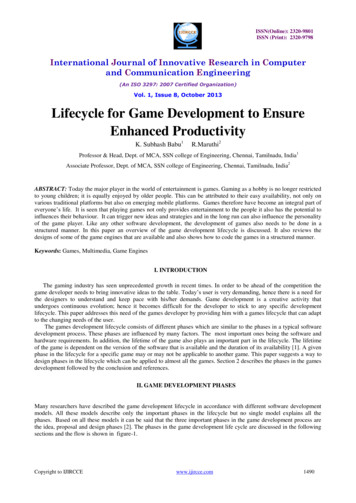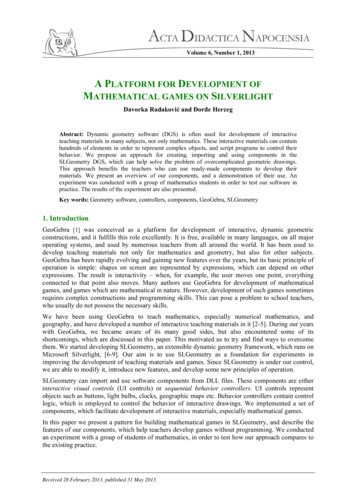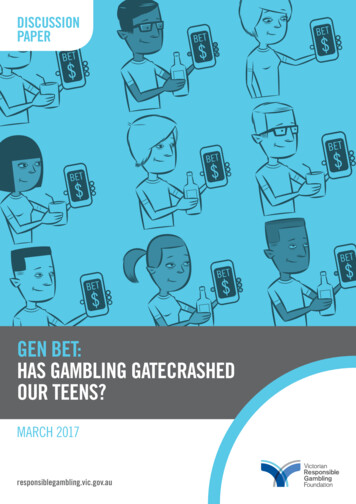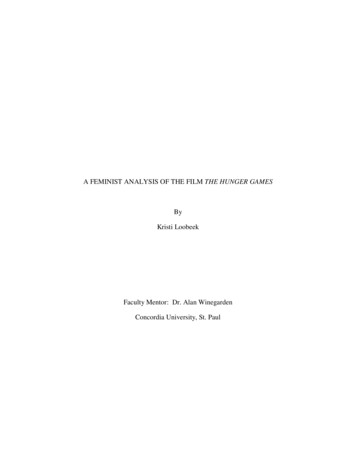
Transcription
Classroom Games and Activities
IndexA Reading Games for Phonics1. Snowball2. Slam3. What’s Missing4. Four in a Row5. Battle RPS6. Make Four456789B Writing Games for Phonics1. Run to the Board2. Bingo1011C Integrated Games for Phonics1. Write and Draw2. Running Dictation3. Listen and Draw121314D Teacher Resources and References1. Online Resources2. ReferencesThis booklet has been prepared by:www.e-future.co.kr4F 6F LK Bldg. 196-8Jamsil-dong, Songpa-gu, Seoul, Korea, 138-862Tel: 82 2 3400-0509 Fax: 82 2 591-76262012 e-future Ltd.All rights reserved.1515
AReading Games for PhonicsA2 SlamA1 SnowballType : Reading GameLevel : All levelsMaterials : FlashcardsType : Reading GameLevel : Lower levelsMaterials : FlashcardsInstructionsInstructions1Select target flashcards and spread them on the table with the letter sides face up.2Put students into two groups.1Select target flashcards and spread them on the table with letter sides up.3Ask a student from each group to put their hands on their heads.2Students take turns reading the cards cumulatively.4Read one of the letter cards. The student who first slams on the correct card winsa point for his/her team.5Repeat steps 3 and 4 .6When students feel confident, have them take your role reading the cards.· Student 1: ham· Student 2: ham, map· Student 3: ham, map, jamAdapting the ActivityAdapting the Activity· Add a rhythm or chanting element.· Conduct activity on the board.· Give students flyswatters to slam the correct answer.· For more advanced classes, add new words with the target sound(s).· For large classes, conduct chorally and increase the speed each turn.· For large classes, post the flashcards on the board.· For more advanced classes, introduce new words with the target sound(s).4Classroom Games and ActivitiesReading Games for Phonics5
A3 What’s MissingA4 Four in a RowType : Reading GameType : Reading GameLevel : All levelsLevel : All levelsMaterials : FlashcardsMaterials : Flashcards, checkers or go game pieces (these could substituted withcoins, colored tokens, or colored sticky notes)Instructions1Select target flashcards and spread them on the table with the letter sides face up.2Put students into two groups.3Group 1 hides a card while group 2 keeps their eyes closed.4Group 2 looks at the flashcards and says what the missing card is. If correct, theywin a point.5The two groups switch their roles and repeat steps 3 and 4 .Instructions1Select 16 target flashcards and arrange them on a large table or on the floor in a4 x 4 grid.2Put students into two groups and give each group a set of game pieces.3Groups take turns reading a card. When reading correctly, they can put their team'sgame piece marker on the card.4When the game pieces are placed on all the cards, calculate the points each groupearned: 2 points for the game pieces that are placed two in a row, 3 points for themarkers that are placed three in a row and 4 points for the game pieces that areplaced four in a row.5The winner is the group with more points.Adapting the Activity· For larger classes, break the class into smaller groups.· For more advanced classes, add new words with the target sound(s).Adapting the Activity· For larger classes, break the class into, smaller groups.· For more advanced classes, create cards with sentences that have the target words.For example: Target words - nine; bikeIt is nine.6Classroom Games and ActivitiesTom has a bike.Reading Games for Phonics7
A6 Make Four!A5 Battle RPSType : Reading GameType : Reading GameLevel : All levelsLevel : All levelsMaterials : FlashcardsMaterials : Flashcards, group headings for sortingInstructions1InstructionsSelect target flashcards and line them up on the table with the letter sides face up.Place the target flashcards in a pile.2Students take turns selecting a card from the pile and placing it on the table underthe correct heading. Help students arrange the cards as shown below:mathatpanramcapbatcandammap1 am ap an atrammapfancatpanhat2Put students into two groups. Each group lines up at either end of the table.3Students from each group move up one card at a time while reading the card. Whenthey meet in the middle, they play Rock-Paper-Scissors. The winner stays. The losergoes back to the starting point and another student from the group takes over.4Repeat step 3 .bat5The winner is the group to first reach the other end.matAdapting the Activity3The student who places the fourth card in a column can take the all four cards.4Continue the game until all the cards are played. The winner is the student with themost cards.· For more advanced classes, add new words with the target sound(s).Adapting the Activity· For more advanced classes, add new words with the target sound(s) or havestudents think of new words to place under the headings.8Classroom Games and ActivitiesReading Games for Phonics9
BWriting Games for PhonicsB2 BingoB1 Run to the BoardType : Writing GameLevel : All levelsMaterials : Flashcards, a bingo board (5 x 5)Type : Writing GameLevel : All levelsMaterials : FlashcardsInstructionsInstructions1Split the class into two teams. Have the two teams line up at the back of theclassroom.2When ready, show a flashcard with the picture side facing the students.3The first students in each line run to the board and write the word for the picture.4The first student who writes the word neatly and correctly gets a point for his/herteam.5Repeat steps 3 and 4 . The winner is the team with the most points.1Give each student a bingo board.2Select 25 target flashcards. Read each card as students write the word on theirbingo board. Make sure students understand that they can write the word anywhereon the grid as they like. (Instead of reading the card, you can show each card withthe picture side.)3Play Bingo: Call out the target word. Students mark the square with a check, dot orother symbol.4Repeat step 3 . The winner is the student who creates a line. This line can bestraight or diagonal.Adapting the ActivityAdapting the Activity· For less advanced classes, post the target flashcards on the board. Read out thetarget word and have students touch the correct flashcard.· For more advanced classes, add new words with the target sound(s).· For less advanced classes, show both sides of the flashcard.· To make the game longer, have students make a square, a cross, an X, or another shapeto win.· To make the game shorter, use a smaller bingo board (3 x 3 or 4 x 4).· For more advanced classes, read the target word with a short sentence. Have thestudents write the sentence.10Classroom Games and ActivitiesWriting Games for Phonics11
CIntegrated Games for PhonicsC2 Running DictationC1 Draw and WriteType : Integrated GameLevel : Higher levelsMaterials : Pre-prepared target sentences on paperType : Integrated ActivityLevel : Higher levelsMaterials : Worksheet with four boxes with linesInstructionsInstructions1Create a worksheet with four boxes and lines to write below the boxes.2Use the target words from the unit and create simple sentences.3Write the sentences on the board. Have students write the sentences on the lines.Have them illustrate the sentences in the boxes.1Create a list of target words or sentences and print on cards.2Go to an open area or move the desks to one side of the room. Post the cards onone side of the classroom. Separate the class into pairs. One student will be therunner. The other student will be the writer.writers at desksSampleClassroomLayoutcards posted on wallRunners going back and forthI bake cakes.I bake cakes.The rake is in the lake.The rake is in the lake.3The runners go to the card, read it, and run back to the writer. The runner tells(dictates) the writer what was on the card. The runner goes back to the card asmany times as necessary.4The team to finish the dictation first wins.Adapting the ActivityAdapting the Activity· For less advanced classes, print the target sentences on the worksheet and havethem only draw the pictures. Have students read the target sentences.· For less advanced classes, create a list of words instead of sentences.· For more advanced classes, create longer sentences or introduce new words with thetarget sound(s).· For more advanced classes, have students label the different target words in theirpictures.· For more advanced classes, create sentences with new words with the target sound(s).12Classroom Games and ActivitiesIntegrated Games for Phonics13
C3 Listen and DrawType : IntegratedDTeacher Resources and ReferencesD1 Online ResourcesLevel : Higher levelsMaterials : Notebook, drawing paper, crayons or pencil crayonsInstructions1Write a list of target words on the board. Tell students to choose one or moretarget words and make a sentence with them in their notebooks.2Circulate around the room and give feedback to students on their sentences.Make corrections as needed.3Put students into pairs. Tell the students they have five minutes to complete theactivity. Student A will show student B his/her sentence. Student B will write thesentence on the bottom of a piece of drawing paper and draw a picture toillustrate the sentence. Student B will show his/her sentence to student A. StudentA will write the sentence on the bottom of a piece of drawing paper and draw apicture to illustrate the sentence.4After each student is done drawing, have the pairs check to make sure the pictureis correct. Repeat as time allows.Activity sheets and other resourceshttp://www.funfonix.com/Free downloadable activity sheetshttp://www.sparklebox.co.uk/Printable resources for letters and soundshttp://www.letters-and-sounds.com/Collection of links for teachers of young learnershttp://www.internet4classrooms.com/kplus phonics.htmD2 References· Bear, D.R. & Templeton, S. (1998). Explorations in developmental spelling: Foundationsfor learning and teaching phonics, spelling and vocabulary. The Reading Teacher 52(3),222-242.· Cunningham, P.M. & Cunningham, J.W. (2002). In Farstrup & Samuels (Eds.), WhatAdapting the Activity· For more advanced classes, have students write a short story with the target words.· For more time, create a story with the target words. Make a booklet with the story andhave the students illustrate it. For more advanced students, create the story as a groupand have them create a booklet for the story.Research Has to Say About Reading Instruction (3rd ed.), 87-109.· Stahl, S. (1992). “Saying the “p” word: Nine guidelines for exemplary phonics instruction.”The Reading Teacher, 45(8), 618-625.· Stahl, Duffy-Hester, & Stahl. (1998). Everything you want to know about phonics(but were afraid to ask). Reading Research Quarterly, 33(3), 338-355.· Trachtenburg, P. (1990). "Using children's literature to enhance phonics instruction"The Reading Teacher. May. 648-654.14Classroom Games and ActivitiesTeacher Resources and References15
Also Available with New Smart PhonicsPhonics Game CardsFlashcardsPhonics BuildersBig Game BooksPhonics Fun Readerswww.e-future.co.kr
A6Make Four! Type: Reading Game Level: All levels Materials: Flashcards, group headings for sorting 1 Place the target flashcards in a pile. 2 Students take turns selecting a card from the pile and placing it on the table under the correct heading. Help students arrange the cards as shown below: 3 The student who places











